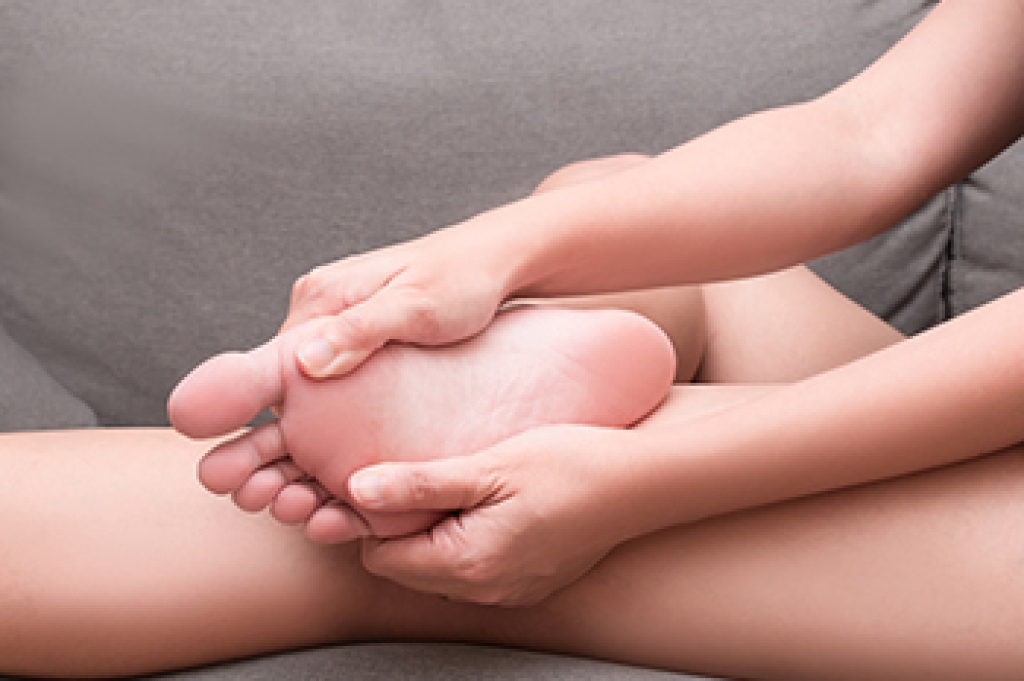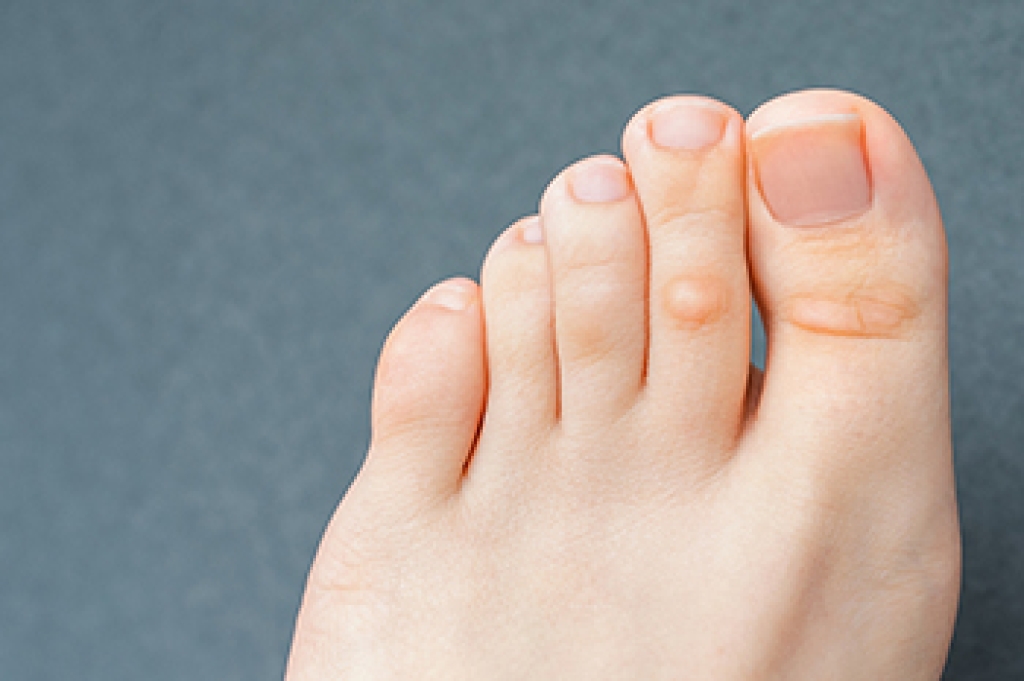Connect With Us
Blog
Blog
Understanding Sesamoiditis

Sesamoiditis is an inflammation of the small bones located beneath the big toe joint. These bones help with balance and movement, but can become irritated from repetitive pressure, high-impact activities, or wearing shoes that lack proper cushioning. Dancers, runners, and athletes who frequently push off from the ball of the foot are more prone to developing this condition. Symptoms may include localized pain, swelling, and tenderness that worsens during activity. Resting the foot and wearing supportive footwear with cushioned insoles can help relieve discomfort. In some cases, activity modification and targeted stretches are recommended to prevent recurrence. Paying attention to early signs can help you avoid more serious injury and prolonged healing time. If foot pain interferes with daily movement, it is suggested that you consult a podiatrist for proper evaluation and appropriate treatment.
Sesamoiditis is an unpleasant foot condition characterized by pain in the balls of the feet. If you think you’re struggling with sesamoiditis, contact Dr. Castillo of Bronx Foot Care. Our doctor will treat your condition thoroughly and effectively.
Sesamoiditis
Sesamoiditis is a condition of the foot that affects the ball of the foot. It is more common in younger people than it is in older people. It can also occur with people who have begun a new exercise program, since their bodies are adjusting to the new physical regimen. Pain may also be caused by the inflammation of tendons surrounding the bones. It is important to seek treatment in its early stages because if you ignore the pain, this condition can lead to more serious problems such as severe irritation and bone fractures.
Causes of Sesamoiditis
- Sudden increase in activity
- Increase in physically strenuous movement without a proper warm up or build up
- Foot structure: those who have smaller, bonier feet or those with a high arch may be more susceptible
Treatment for sesamoiditis is non-invasive and simple. Doctors may recommend a strict rest period where the patient forgoes most physical activity. This will help give the patient time to heal their feet through limited activity. For serious cases, it is best to speak with your doctor to determine a treatment option that will help your specific needs.
If you have any questions, please feel free to contact our offices located in Bronx, NY Yonkers, NY . We offer the newest diagnostic and treatment technologies for all your foot care needs.
Understanding Corns and Calluses

Corns and calluses are areas of thickened, hardened skin that develop on the feet due to repeated pressure or friction. Corns are smaller, more localized, often forming on toes, while calluses are larger and usually appear on the soles. Causes include poorly fitting shoes, abnormal gait, or frequent walking and standing. Symptoms include bumpy, raised patches of skin that can feel rough or hard. Corns may cause sharp pain when pressed, while calluses generally cause mild discomfort or sensitivity. The skin may look yellowish or dry and cracked. A podiatrist can safely remove corns and calluses, assess the underlying cause, and recommend treatments such as custom orthotics, padding, or footwear modifications to prevent recurrence. Regular foot care and addressing pressure points can reduce discomfort and protect your feet. If you are dealing with this issue, it is suggested that you make an appointment with a podiatrist.
Corns can make walking very painful and should be treated immediately. If you have questions regarding your feet and ankles, contact Dr. Castillo of Bronx Foot Care. Our doctor will treat your foot and ankle needs.
Corns: What Are They? And How Do You Get Rid of Them?
Corns are thickened areas on the skin that can become painful. They are caused by excessive pressure and friction on the skin. Corns press into the deeper layers of the skin and are usually round in shape.
Ways to Prevent Corns
There are many ways to get rid of painful corns such as:
- Wearing properly fitting shoes that have been measured by a professional
- Wearing shoes that are not sharply pointed or have high heels
- Wearing only shoes that offer support
Treating Corns
Although most corns slowly disappear when the friction or pressure stops, this isn’t always the case. Consult with your podiatrist to determine the best treatment option for your case of corns.
If you have any questions, please feel free to contact our offices located in Bronx, NY Yonkers, NY . We offer the newest diagnostic and treatment technologies for all your foot care needs.
Why the Right Shoes Matter for Children’s Foot Health

Children’s feet are still growing and developing, making proper foot care and well-fitting shoes essential. Common foot issues in children include flat feet, toe walking, in-toeing, and heel pain, often from Sever’s disease. These problems can be caused by genetics, wearing improper footwear, or overuse during sports and play. Symptoms include limping, frequent tripping, uneven shoe wear, or complaints of foot, ankle, or leg pain. Shoes that are too tight, too loose, or lack support can worsen these issues or cause blisters, calluses, and posture problems. A podiatrist can assess your child’s foot development and walking pattern, recommend proper footwear, and provide custom orthotics, if needed. Early intervention is key to preventing long-term problems and supporting healthy growth. If you suspect your child is having foot issues, it is suggested that you schedule an appointment with a podiatrist for an accurate diagnosis and appropriate treatment solutions.
The health of a child’s feet is vital to their overall well-being. If you have any questions regarding foot health, contact Dr. Castillo of Bronx Foot Care. Our doctor can provide the care you need to keep you pain-free and on your feet.
Tips for Keeping Children's Feet Healthy
- Make sure their shoes fit properly
- Look for any signs of in-toeing or out-toeing
- Check to see if they have Clubfoot (condition that affects your child’s foot and ankle, twisting the heel and toes inward) which is one of the most common nonmajor birth defects.
- Lightly cover your baby’s feet (Tight covers may keep your baby from moving their feet freely, and could prevent normal development)
- Allow your toddler to go shoeless (Shoes can be restricting for a young child’s foot)
- Cut toenails straight across to avoid ingrown toenails
- Keep your child’s foot clean and dry
- Cover cuts and scrapes. Wash any scratches with soap and water and cover them with a bandage until they’ve healed.
If you have any questions, please feel free to contact our offices located in Bronx, NY Yonkers, NY . We offer the newest diagnostic and treatment technologies for all your foot care needs.
How Athlete’s Foot Spreads and Why It Matters

Athlete’s foot is a common fungal infection that affects the skin, usually between the toes. It often begins with itching, burning, or peeling and can spread quickly in warm, moist environments. Locker rooms, shared showers, and damp socks create perfect conditions for this infection to thrive. Athlete’s foot is contagious. It can be passed through direct skin contact or by walking barefoot on contaminated surfaces. Sharing shoes, towels, or even carpets with someone who has it increases the risk. The fungus can also spread to other parts of the body if not treated properly. Because it can be persistent and easily transmitted, early treatment is essential. If symptoms continue or return, it is suggested that you see a podiatrist for an accurate diagnosis and stronger options to prevent spreading or recurrence.
Athlete’s foot is an inconvenient condition that can be easily reduced with the proper treatment. If you have any concerns about your feet and ankles, contact Dr. Castillo from Bronx Foot Care. Our doctor will treat your foot and ankle needs.
Athlete’s Foot: The Sole Story
Athlete's foot, also known as tinea pedis, can be an extremely contagious foot infection. It is commonly contracted in public changing areas and bathrooms, dormitory style living quarters, around locker rooms and public swimming pools, or anywhere your feet often come into contact with other people.
Solutions to Combat Athlete’s Foot
- Hydrate your feet by using lotion
- Exfoliate
- Buff off nails
- Use of anti-fungal products
- Examine your feet and visit your doctor if any suspicious blisters or cuts develop
Athlete’s foot can cause many irritating symptoms such as dry and flaking skin, itching, and redness. Some more severe symptoms can include bleeding and cracked skin, intense itching and burning, and even pain when walking. In the worst cases, Athlete’s foot can cause blistering as well. Speak to your podiatrist for a better understanding of the different causes of Athlete’s foot, as well as help in determining which treatment options are best for you.
If you have any questions please feel free to contact our offices located in Bronx, NY Yonkers, NY . We offer the newest diagnostic and treatment technologies for all your foot and ankle needs.
Blog Archives
- 2025
- 2024
- 2023
- 2022
- 2021
- 2020

